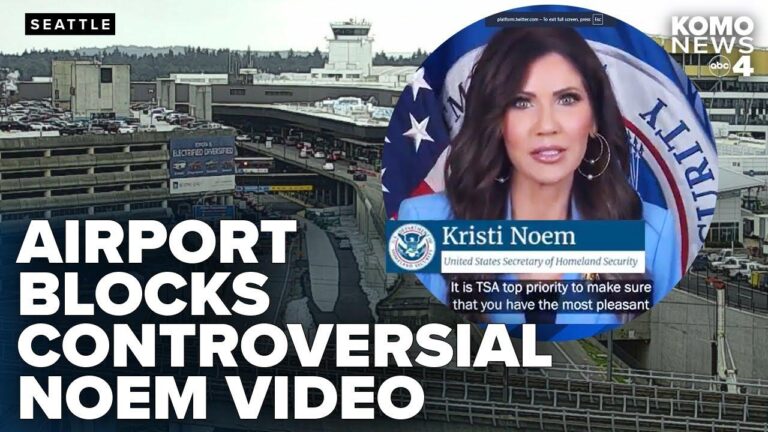Several airports across the United States have taken a stand against a controversial video produced by the Transportation Security Administration (TSA) that places blame on Democratic lawmakers for a government shutdown. The video, which sparked a wave of criticism for its partisan tone, has been rejected by multiple airports unwilling to air politically charged content in their terminals. This development highlights ongoing tensions over the role of government agencies in political messaging amid a fraught federal budget impasse.
Airports Push Back Against Controversial TSA Video Targeting Democrats
Several airports across the nation have expressed strong opposition to a recently released TSA video that explicitly places blame on Democratic lawmakers for the recent government shutdown. Airport officials argue that the video’s partisan message not only undermines the agency’s neutrality but also risks alienating travelers during a time when maintaining public trust and operational efficiency is critical. In direct response, some terminals have chosen to remove or refuse the video from their public display systems, emphasizing their commitment to nonpartisan communication.
Critics of the video point out that:
- Maintaining neutrality: Transportation hubs are designed to serve all passengers regardless of political affiliation.
- Operational disruption: Controversial messaging could provoke protests or lead to heightened tensions in crowded airport environments.
- Public relations concerns: Airports fear damage to their reputations as impartial, welcoming spaces for all travelers.
| Airport | Stance on TSA Video | Action Taken |
|---|---|---|
| Denver International | Opposed | Removed video from terminals |
| Los Angeles International | Neutral | Limited video exposure |
| Chicago O’Hare | Opposed | Issued public statement condemning video |
Analyzing the Political Undercurrents in TSA Communications Amid Government Shutdown
In the wake of the ongoing government shutdown, tensions have surfaced not only in Washington but also on the tarmac and airport terminals nationwide. Some airports have taken a firm stance against a controversial TSA video that directly points fingers at Democrats for the impasse. The decision to reject this video highlights a deeper unease about the increasing politicization of federal agencies and their communications. Airport officials argue that the TSA’s message crosses a line from informational content into partisan messaging, undermining public trust in an agency tasked with security rather than political advocacy.
Key factors driving the backlash include:
- The risk of eroding bipartisan support for TSA operations during critical times.
- Concerns about the video exacerbating passenger anxiety amid service disruptions.
- The focus should be on maintaining safety and service, not fueling political narratives.
| Airport | Response to TSA Video | Reason |
|---|---|---|
| Chicago O’Hare | Rejected | Maintaining neutrality |
| Atlanta Hartsfield | Accepted | Supporting TSA messaging |
| Los Angeles International | Rejected | Concerns over politicization |
| Dallas/Fort Worth | Withdrawn after complaints | Passenger feedback |
Impact of the Shutdown on Airport Operations and Passenger Experience
Flight schedules faced widespread disruptions as the shutdown led to diminished TSA staffing levels, resulting in considerable delays at key security checkpoints. Travelers reported frustration due to lengthened wait times, increasing anxiety and missed connections. Several major airports implemented contingency plans, such as reallocating personnel and extending operational hours, but these measures only somewhat mitigated the impact. The uncertainty also sparked confusion as communication from TSA was often inconsistent, compounding passenger concerns about safety and efficiency during their journeys.
- Extended Wait Times: Security lines doubled, with some lasting over two hours.
- Staff Shortages: TSA agents called in sick or refused overtime amid political tensions.
- Passenger Complaints: Surge in reported missed flights and lost baggage claims.
- Operational Strain: Airports struggled to maintain normal service levels amid reduced federal support.
| Airport | Average Delay | Passenger Feedback |
|---|---|---|
| JFK | 85 minutes | High frustration |
| LAX | 70 minutes | Moderate complaints |
| ORD | 90 minutes | Significant negative impact |
Recommendations for Maintaining Neutrality and Transparency in Public Sector Messaging
Public sector messaging must be carefully crafted to avoid political bias and maintain trust among diverse audiences. Agencies should implement clear guidelines that emphasize factual accuracy and impartiality, steering clear of language that could be interpreted as partisan. This includes rigorous content review processes involving cross-functional teams to ensure that communications represent the government’s role fairly without assigning blame or favoring any political party.
Transparency is equally crucial in sustaining public confidence. Officials should provide clear context for all messages, including sources and intentions, allowing audiences to understand the full scope of a situation without manipulation. Establishing regular channels for feedback and fact-checking can help identify and correct unintentional biases early on. Consider the following strategies:
- Multi-level review: Involve legal and ethical advisors to vet messaging content.
- Balanced language: Use neutral phrasing that avoids attributing blame.
- Fact disclosure: Offer verifiable data alongside statements to support transparency.
- Public engagement: Facilitate Q&A sessions to clarify messaging and address concerns.
| Strategy | Benefit |
|---|---|
| Neutral phrasing | Reduces partisan perceptions |
| Fact-based disclosures | Enhances credibility |
| Inclusive reviews | Ensures ethical compliance |
| Open feedback loops | Builds public trust |
Wrapping Up
As the political debate over the government shutdown continues, the controversy surrounding the TSA’s video blaming Democrats underscores the deep partisan divisions affecting federal agencies. Several airports’ decisions to reject the video highlight ongoing tensions between politics and public communication during this period of uncertainty. Moving forward, how agencies navigate these challenges will remain a closely watched aspect of the shutdown’s broader impact.




